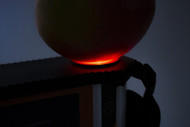NIR Quality Meters Improve Produce Yield and Quality
14th Jan 2021
Today, food quality is controlled every step of the way, from the farm to the retailer. The days of conventional, subjective quality estimation are in the past, meeting neither demand from consumers, nor the stringent regulatory controls in place throughout the world. Thus, portable, technologically sophisticated tools that provide accurate measurements in real-time are revolutionizing modern food production.
Near-Infrared Spectroscopy
The Near-Infrared (NIR), which exists between wavelengths 750-2500 nanometers (nm), lies outside the visible range of light. NIR interacts with the compounds and chemical structures within plants. Thus, the plant’s composition determines how much light is absorbed, reflected, or transmitted. Each compound produces a unique spectral signature that can identify its presence and concentrations. This property of NIR spectroscopy is used to measure several vital quality parameters.
These parameters are used for:
● Fixing harvest time for climacteric and non-climacteric fruits
● Postharvest quality management of food during storage, transport, and retailing
● Selecting farm produce and controlling the processing of food into wines, jams, oils, etc.
● Meeting quality standards set for national and international trade in fresh produce
● Research in breeding new varieties
Quality Parameters

Figure 1: Changes in the spectral signature as the tomato ripens, Li et al 2018. (Image credits: https://doi.org/10.3390/plants7010003)
As fruits develop and grow, they accumulate several compounds that directly impact taste, appearance, and nutritional quality. Thus, the proper quality parameters to assess will vary between fruits.
NIR tools can non-destructively measure many common parameters used to measure the quality of fruits, such as total soluble sugars (TSS), dry matter content (DM), titrable acidity, and color.
- TSS: Sugars are a major component in fruits and are monitored throughout the supply chain. Sugars are also the main compounds accumulated by non-climacteric fruits during maturity and ripening. Once fruits reach the recommended levels farmers can move confidently to harvest.
- DM: The total of all compounds like sugars, starches, proteins, anthocyanins, vitamins, etc., present in the fruit, minus its water content, make up dry matter. Climacteric fruits accumulate starch to reach maturity and during ripening convert starch to sugars by producing ethylene.Hence, DM is becoming an important quality parameter for climacteric fruits, as maturity measurements at harvest time can predict postharvest quality.
- Titratable acids: Organic acids are produced by many fruits and a correct balance with sweetness is important in deciding taste. The acids differ depending on the fruit. For example, tartaric acid is measured in grapes and citric acid in citrus.
- Color: Fruits and vegetables get their color from a range of pigments; for example, anthocyanins make grapes red to purple. Pigments react strongly with NIR to produce distinct spectral signatures and provide a quantitative and objective measure of skin color, which is universally used to decide harvest time and fruit quality, see Figure 1.
NIR Devices
Fresh Produce Instruments supplies Felix Instruments Applied Food Sciences' series of NIR tools that measure TSS, DM, titratable acidity, and internal and external color. The F-750, which was the first in the series, has been customized for major fruits and includes popular varieties. All the instruments are equipped with GPS and are compatible with Fruit Maps, a harvest mapping and prediction tool.
Felix’s instrument line includes:
- F-750 Produce Quality Meter, which can be used for all fresh produce using model building, has also been tested for fish. Its use can be extended to milk and milk products, fodder, and meat products.
- F-751-Avo is customized to measure dry matter - an indirect estimate of oil content and the primary quality parameter in avocados.
- F-751-Mango is used throughout the supply chain to measure Brix and dry matter in mangoes.
- F-751-Kiwi measures quality parameters in kiwis and is used by growers, traders, and researchers.
Small Yet Precise
These tools supplied by Fresh Produce Instruments, based on miniaturized spectroscopy, earlier confined to laboratories, give individual readings within seconds. The readings are easy to process and store in the device for later download. There are prepared models for several fruits, and easy instructions for the creation of new ones. Since the quality analysis from these devices is non-destructive, it saves yields and preempts the use of chemicals throughout the supply chain, making it the environmentally friendly choice as well.
Sources
Atkinson, R. G., Brummell, D. A., Burdon, J. N., Patterson, K. J., & Schaffer R. J. (2015). Chapter 11 - Fruit growth, ripening and post-harvest physiology. In B. Atwell, P. Kriedemann & C. Turnbull (Eds.), Plants in Action. Retrieved from http://www.asps.org.au/wp-content/uploads/Chapter-11-Fruit-growth-ripening-and-post-harvest-physiology.pdf
Colours in vegetables, a work of chemistry. Retrieved from https://www.worldofchemicals.com/128/chemistry-articles/colours-in-vegetables-a-work-of-chemistry.html
De Baerdemaeker J., Jancsók P.T., & Verlinden B.E. (2002). Firmness and Softening of Fruits and Vegetables. In: Blahovec J., Kutílek M. (eds) Physical Methods in Agriculture. Springer, Boston, MA. https://doi.org/10.1007/978-1-4615-0085-8_18
Escribanoa, S., Biasia, W.V., Lerudb, R., Slaughterc, D.C, & Mitcham, E.J. (2017). Non-destructive prediction of soluble solids and dry matter content using NIR spectroscopy and its relationship with sensory quality in sweet cherries. Postharvest Biology and Technology, 128 (112-120). https://doi.org/10.1016/j.postharvbio.2017.01.016
García-Sánchez, F., Galvez-Sola, L., Martínez-Nicolás, J.J., Muelas-Domingo, R., & Nieves, M. (2017). Using Near-Infrared Spectroscopy in Agricultural Systems. Developments in Near-Infrared Spectroscopy. Editors: Kyprianidis, K., & Skvaril, J. Tech Open. DOI: 10.5772/67236
Ping, Z., Zhihua, Z., Jihong, Y., Qingsheng, L., Zhiying, F., & Weixi, L. (2006). Application of NIR Technology in the Quality Detection for Foodstuff. Retrieved from http://en.cnki.com.cn/Article_en/CJFDTotal-XDYQ20...

